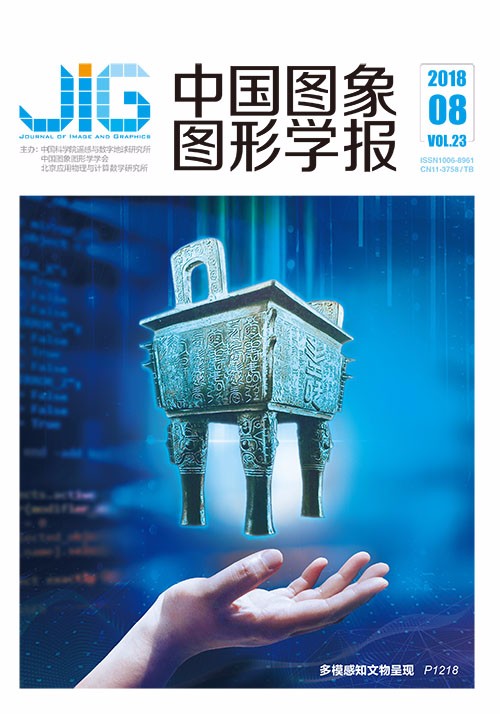
结合分数阶微分和图像局部信息的CV模型
摘 要
目的 由于CV模型仅利用了图像的全局信息,其对灰度不均匀图像的分割效果不理想,同时在分割弱边缘和弱纹理图像时,优化易陷入局部最优从而导致分割效率低下,且对初始位置的选择较为敏感。针对这些问题,提出一种结合分数阶微分和图像局部信息的CV模型。方法 首先将分数阶梯度信息融入图像的局部信息中,用来替代CV模型的整数阶全局信息,并建立自适应计算分数阶最佳阶次的数学模型,然后在模型中加入符号距离的约束项。结果 一方面,用局部信息代替全局信息,可以在一定程度上解决CV模型对灰度不均匀图像分割效果不理想的问题。另一方面,将Grünwald-Letnikov分数阶梯度信息融合到局部信息中,当分数阶阶次0 < α < 1时,增加了图像灰度不均匀、弱边缘、弱纹理区域的梯度信息,从而增加了演化驱动力避免演化曲线陷入局部最优,有效地解决了图像因灰度变化不大导致演化曲线驱动力小的问题,在一定程度上解决了模型对初始轮廓位置选择和对噪声敏感的问题。同时为了解决人工选取最佳分数阶阶次费时费力的问题,根据图像的梯度模值和信息熵建立计算分数阶最佳阶次的数学模型,将此自适应分数阶模型应用到算法之中,以自适应确定最佳分数阶阶次。此外,为了避免模型的重新初始化,在模型中加入符号距离的约束项,从而提高了曲线的演化效率。结论 理论分析和实验结果均表明,该算法能够较好地分割灰度不均匀、弱边缘和弱纹理区域的图像,并能根据图像特征自适应确定最佳分数阶阶次,提高了分割精度和分割效率,且对初始轮廓位置选择及噪声均具有一定的鲁棒性。
关键词
New CV model combining fractional differential and image local information
Zhang Guimei1, Chen Bingbing1, Xu Ke2, Chu Jun1(1.Key Laboratory of Image Processing and Pattern Recognition, Nanchang Hangkong University, Nanchang, 330063, China;2.Pilot School of Microelectronics, University of Electronic Science and Technology of China, Chengdu 611731, China) Abstract
Objective Presently, the segmentation of intensity inhomogeneous images, weak edges, and weak texture images remains a challenge. The CV model alone is not ideal for the segmentation of intensity inhomogeneous image due to using the global information of the image. In the segmentation of weak edges and weak texture images, optimization easily falls into the local optimum, leading to the low efficiency of segmentation and the sensitive selection of the initial position. Method To address these problems, a new CV model combining fractional differential and image local information is proposed for image segmentation. the algorithm first integrates fractional gradient information into the local information of the image, replacing the integer order global information of the CV model. An adaptive fractional mathematical model is then constructed according to the gradient modulus and the information entropy of the image. Using the mathematical model as basis, the optimal fractional order can be obtained adaptively. Finally, the symbol distance constraint item is added to the model. Result The CV model is an active contour model based on global information, and it works well in segmenting images with homogeneous intensity. However, the CV model is not ideal for the segmentation of intensity inhomogeneous images because it only uses the global information of the image. The local information in the LBF model can be used to replace the global information in the CV model, thereby solving the segmentation of intensity inhomogeneous images. We then use local information instead of the global information, handling the limitation of the CV model in segmenting images with inhomogeneous intensity to a certain extent. In addition, by integrating G-L fractional gradient information into local information, when the fractional order is between 0 and 1, the algorithm increases the gradient information in these regions of inhomogeneous intensity, weak edge, and weak texture. Doing so increasing the driving force of evolution to prevent evolutionary curve from falling into the local optimum and effectively solving the little driving force of the image for the evolvement curve due to the small change of intensity. Furthermore, when the fractional order is between 0 and 1, the fractional differential enhancement of high-frequency signals is less than that of integer-order differential pairs of high-frequency signals. Therefore, fractional differential relatively suppresses noise and has a certain anti-noise ability. Our model can solve the selection of the initial contour position and the sensitivity of the model to noise to an extent. To address the time-consuming and labor-intensive selection of the optimal fractional order, a mathematical model for calculating the optimal order is established according to the gradient modulus and the information entropy of the image, and the adaptive fractional order model is applied to the algorithm to adaptively determine the optimal fraction order. To correct the deviation of the level set function and symbol distance function and avoid the re-initialization of the model, the symbol distance constraint term is added to the model so as to improve the evolution efficiency of the curve. Conclusion Theoretical analysis and experimental results show that the proposed algorithm can segment images with inhomogeneous intensity, weak edge, and weak texture regions, improving the segmentation accuracy and efficiency. Moreover, the optimal order of fraction order derivative can be adjusted adaptively, solving the time-consuming and labor-intensive selection of the optimal fractional orders. The use of fraction order derivative can enhance the weak edge and texture regions without substantially increasing the noise signal. To verify the robustness to the initial selection of evolution curve of the algorithm, five different initial contour positions were selected for the two images, and four different noise images were tested to verify the anti-noise performance of the algorithm. Experimental results demonstrate that our model can correct segment the target contour and has good stability to noise. Our model is robust to the initial selection of evolution curve and noise.
Keywords
image segmentation fraction order derivative local information CV model adaptive intensity inhomogeneous
|



 中国图象图形学报 │ 京ICP备05080539号-4 │ 本系统由
中国图象图形学报 │ 京ICP备05080539号-4 │ 本系统由